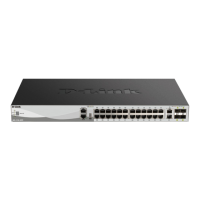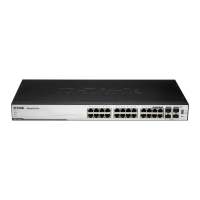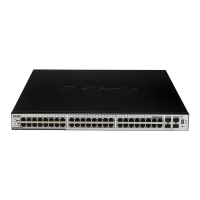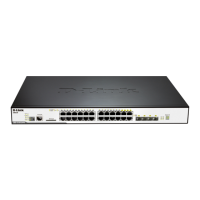DGS-3000 Series Layer 2 Managed Gigabit Switch CLI Reference Guide
372
rx_only - Configures the specified port(s) to receive LLDP packets from neighbors.
tx_and_rx - Configures the specified port(s) to both transmit and receive LLDP packets.
disable - Disable LLDP packet transmit and receive on the specified port(s).
mgt_addr - Specifies the management address used.
ipv4 - Specifies the IPv4 address used.
<ipaddr> - Enter the IP address used for this configuration here.
ipv6 - Specifies the IPv6 address used.
<ipv6addr> - Enter the IPv6 address used for this configuration here.
enable - Specifies that the advertising indicated management address instance will be
enabled.
disable - Specifies that the advertising indicated management address instance will be
basic_tlvs - Specifies the basic TLV data types used from outbound LLDP advertisements.
all - (Optional) Specifies that all the basic TLV data types will be used.
port_description - (Optional) This TLV optional data type indicates that LLDP agent should
transmit Port Description TLV on the port. The default state is disabled.
system_name - (Optional) This TLV optional data type includes indicates that LLDP agent
should transmit System Name TLV. The default state is disabled.
system_description - (Optional) This TLV optional data type includes indicates that LLDP
agent should transmit System Description TLV. The default state is disabled.
system_capabilities - (Optional) This TLV optional data type includes indicates that LLDP
agent should transmit System Capabilities TLV. The system capability will indicate whether
the device provides repeater, bridge, or router function, and whether the provided functions
are currently enabled. The default state is disabled.
enable - Specifies that the basic TLV data types used from outbound LLDP advertisements
will be enabled.
disable - Specifies that the basic TLV data types used from outbound LLDP advertisements
dot1_tlv_pvid - This TLV optional data type determines whether the IEEE 802.1 organizationally
defined port VLAN ID TLV transmission is allowed on a given LLDP transmission capable port.
The default state is disable.
enable - Specifies that the Dot1 TLV PVID option will be enabled.
disable - Specifies that the Dot1 TLV PVID option will be disabled.
dot1_tlv_protocol_vid - This TLV optional data type determines whether the IEEE 802.1
organizationally defined port and protocol VLAN ID TLV transmission is allowed on a given
LLDP transmission capable port. The default state is disable.
vlan - Specifies the VLAN used for this configuration.
all - Specifies that all the configured VLANs will be used for this configuration.
<vlan_name 32> - Enter the name of the VLAN here. This name can be up to 32
characters long.
vlanid - Specifies the VLAN ID used for this configuration.
<vlanid_list> - Enter the ID of the VLAN here.
enable - Specifies that the Dot1 TLV protocol VID will be enabled.
disable - Specifies that the Dot1 TLV protocol VID will be disabled.
dot1_tlv_vlan_name - This TLV optional data type indicates whether the corresponding Local
System’s VLAN name instance will be transmitted on the port. If a port is associated with
multiple VLANs. those enabled VLAN ID will be advertised. The default state is disable.
vlan - Specifies the VLAN used for this configuration.
all - Specifies that all the configured VLANs will be used for this configuration.
<vlan_name 32> - Enter the name of the VLAN here. This name can be up to 32
characters long.
vlanid - Specifies the VLAN ID used for this configuration.
<vlanid_list> - Enter the ID of the VLAN here.
enable - Specifies that the Dot1 TLV VLAN name will be enabled.
disable - Specifies that the Dot1 TLV VLAN name will be disabled.
dot1_tlv_protocol_identity - This TLV optional data type indicates whether the corresponding
Local System's Protocol Identity instance will be transmitted on the port. The Protocol Identity
TLV provides a way for stations to advertise protocols that are important to the operation of
the network. Such as Spanning Tree Protocol, the Link Aggregation Control Protocol, and
numerous vendor proprietary variations are responsible for maintaining the topology and

